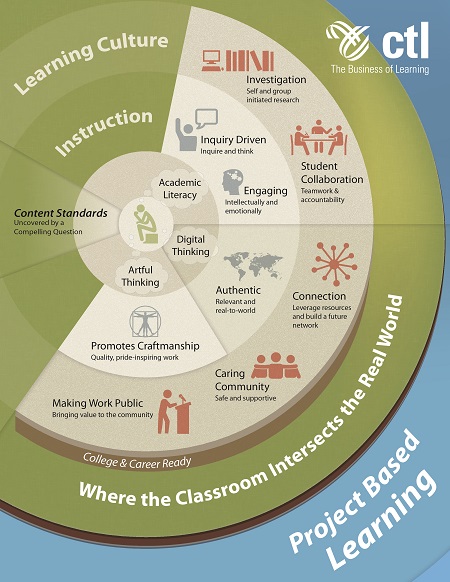You are probably asking yourself, what is Artful Thinking? We at CTL asked ourselves the same question as we sought to define how the arts play a critical role in PBL classrooms. We established Artful Thinking as a way of supporting students in approaching learning, problem solving and creating using an artist’s perspective and design thinking. In particular, the process of design thinking with brainstorming, ideation, prototyping, testing and refining mirrors the artistic process and is especially appropriate for STEM/STEAM projects. An example of Artful Thinking can be seen when students are challenged to design a new surfboard prototype for beginning surfers. Design thinking and attention to aesthetics may lead to this series of questions:
- What problem are the students trying to solve in developing ideas for a surfboard (boards that are more buoyant)?
- What are some original or unique approaches that would address the problem?
- What might a prototype look like based on one of the approaches?
- How can the prototype be tested and what can be learned from the test?
- What refinements are made to create a surfboard that will address the original problem and that represents the next generation of thinking about surfboards?
- What aesthetic qualities need to be addressed in the design so that it has market appeal and functionality?
- How can design of the surfboard project emphasize craftsmanship so that students complete their best work and take pride in the final product?
- Artful Thinking uses the arts to design projects and products in creative and unique ways.
- The idea of multiple perspectives prevalent in the arts informs the way students and their teachers approach project and product development.
- Craftsmanship is a key feature of Artful Thinking, meaning students refine their thinking and the work they produce, striving for higher levels of quality so that they feel pride in the final product.
- While many projects involve the arts, whether in arts production or in the design qualities of the final product, Artful Thinking helps students individually and as part of a community solve design issues in ways that pay attention to aesthetics.
 Artful Thinking is a central component of CTl’s Project Based Learning model[/caption]
From its inception in the mid 1990s, CTL has incorporated into its work inquiry based approaches to classroom instruction, as well as a healthy dose of the arts to spur creative thinking and artistic expression. For more than 20 years, the arts have remained a hallmark of our professional development, arts program evaluation and other arts-related initiatives.
Several years ago we endeavored to codify our inquiry based approaches into a formalized project based learning (PBL) model, drawing on what we’ve learned and developed over the years. (See an earlier post on our model: CTL’s Vision of Schooling Includes Project Based Learning, and our completed model page.) We believe our PBL model is both comprehensive and nuanced, and what distinguishes it from others is in part the emphasis on Artful Thinking, as shown in the graphic included in this post.
One final note: there exists a wealth of videos on YouTube describing and demonstrating project based learning and arts integration. These videos provide examples of how teachers and students work together to develop products and performances that are strengthened through application of the arts, whether it be students creating an arts walking tour in their community along with their own original kinetic art, or designing an object for flight that embeds science, technology and engineering principles as well as the aesthetics of an original and creative design. (See the Community Arts and Science Project in Anatomy of a Project: Kinetic Conundrum; also, the Wing Project from Aviation HS: Manage the Process.)
If you want to learn more about Artful Thinking or CTL’s PBL model, post a reply below or contact Deborah Walker (dwalker@ctlonline.org) or Roland O’Daniel (rodaniel@ctlonline.org).]]>
Artful Thinking is a central component of CTl’s Project Based Learning model[/caption]
From its inception in the mid 1990s, CTL has incorporated into its work inquiry based approaches to classroom instruction, as well as a healthy dose of the arts to spur creative thinking and artistic expression. For more than 20 years, the arts have remained a hallmark of our professional development, arts program evaluation and other arts-related initiatives.
Several years ago we endeavored to codify our inquiry based approaches into a formalized project based learning (PBL) model, drawing on what we’ve learned and developed over the years. (See an earlier post on our model: CTL’s Vision of Schooling Includes Project Based Learning, and our completed model page.) We believe our PBL model is both comprehensive and nuanced, and what distinguishes it from others is in part the emphasis on Artful Thinking, as shown in the graphic included in this post.
One final note: there exists a wealth of videos on YouTube describing and demonstrating project based learning and arts integration. These videos provide examples of how teachers and students work together to develop products and performances that are strengthened through application of the arts, whether it be students creating an arts walking tour in their community along with their own original kinetic art, or designing an object for flight that embeds science, technology and engineering principles as well as the aesthetics of an original and creative design. (See the Community Arts and Science Project in Anatomy of a Project: Kinetic Conundrum; also, the Wing Project from Aviation HS: Manage the Process.)
If you want to learn more about Artful Thinking or CTL’s PBL model, post a reply below or contact Deborah Walker (dwalker@ctlonline.org) or Roland O’Daniel (rodaniel@ctlonline.org).]]>
